Ceiling split system: types of equipment and features of its installation + rating TOP-10 of the best models
Modern ceiling-type air conditioning systems are very diverse in design, appearance and installation features. Have you thought about purchasing such a device, but don’t know which is better to choose to equip a room? We will help you make the right choice so that you can stop at the right equipment for your apartment, home or office.
Let's look at what constitutes a ceiling split system and what is the specificity of its work. We also consider the popular types of equipment, their design features, the nuances of the selection and installation of HVAC equipment.
Additionally, the article contains photos, diagrams and video instructions that will help to thoroughly understand the issue of choosing split-systems of ceiling type.
The content of the article:
Types and design of ceiling systems
The ceiling type of devices is one of the varieties of air conditioners for domestic and semi-industrial use. Consists of two blocks: condensing - for outdoor use, and an evaporator designed for indoor installation.
Some models are distinguished by the presence of additional optional features, for example, they heat the air and carry out its thorough filtering.

Consider the most popular types of air conditioners with ceiling type mounting.
View # 1 - air conditioning cassette
This type of device is considered the optimal solution for objects where it is important to evenly distribute chilled air flows. The devices are installed in the inter-ceiling space, therefore they are suitable for any interior and do not spoil its appearance, like a wall-mounted type of systems.
Most often they use products for equipment of apartments, houses, cottages with high ceilings - more than 3 meters, offices, halls, cinemas, shopping centers, restaurants and other large-sized rooms.
Also, cassette devices can be used as one or more elements of a multi-split system: they are designed to maintain the necessary microclimate in several office rooms, shops, warehouses, etc.
The design of the equipment includes 2 autonomous units for internal and external placement, connected by a route.
The market is mainly represented by square-shaped models of standard sizes - about 600 mm on each side. They differ in various cooling capacity, heating, functionality and level of energy savings.
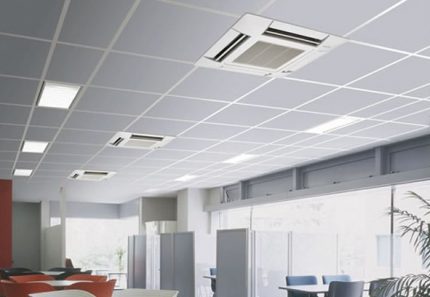
One of the advantages of cassette systems is the concealment of device communications in the suspended part of the ceiling.
In the center of the structure of the indoor unit there is a decorative grille, on the sides of which there are 4 exit slots with rotary blinds. The grill performs the function of intake of warm air, which occurs due to the operation of the axial fan.
Further, the air masses pass through the heat exchanger of the evaporator, where the cooling process takes place. Freon is the working substance for moving the heat energy of air flows.
Already chilled masses are returned to the room and evenly distributed through adjustable blinds. Their tilt level can be changed using the remote control.
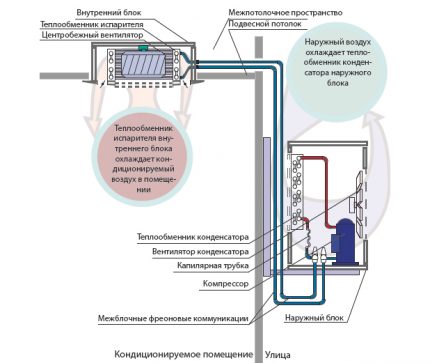
The external unit of the technical fixture is installed on the facade of the building and connected to the internal structure using a line of copper tubes for circulation of the refrigerant.
The main advantages of the cassette-type system:
- air distribution in 4 directions;
- rapid cooling / heating of air;
- neat design of the decorative panel;
- low noise level.
Some models are distinguished by the presence of such functions as air ventilation, automatic temperature maintenance, night mode of use, self-diagnosis of system errors and malfunctions, storing of selected settings, preventing ice formation and others.
In addition, the system has some drawbacks - high cost, in comparison with wall mounted devices, and the ability to install only in the space between the main and the suspended part of the ceiling structure. This type of device is not suitable for apartments with ceilings 250-270 cm high.
In more detail, we considered the issue of mounting a cassette split system in another our article.
View # 2 - channel split system
The devices have a similar design with the previous view. The main distinguishing feature of the technology is the supply and exhaust ventilation due to the air channel.
Install such systems in multi-room apartments, offices, shops and other large-sized premises.

The outer part is a structure of the main unit, the supply and exhaust duct. The number of ducts can be adjusted independently depending on the area that needs to be conditioned.
The indoor unit is located inside the ceiling structure, so that the communication system and the device casing are hidden above the suspended ceiling. The installation location of the unit should be selected in the middle of the house or other room in order to evenly position the air ducts.
In the hidden part of the ceiling of the rooms, the required number is set ductwork to provide air conditioning for all rooms. Each exit is closed with a decorative panel with a grill.
In the internal part of the structure is the evaporator heat exchanger, fan. The unit is also equipped with an air filter, temperature sensors, a remote control signal receiving unit.
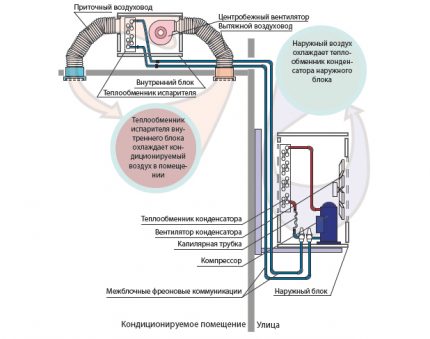
The duct unit is designed for air conditioning of recirculation air. However, its special design allows cooling / heating of the mass with a mixture of fresh air up to 30%.
Often this type of ceiling air conditioners is used in supermarkets or large offices where there are sufficiently high ceilings and there is no need to select the temperature for each room individually.
For the arrival of fresh air masses, a special channel is provided through which they are fed into the indoor unit for processing.
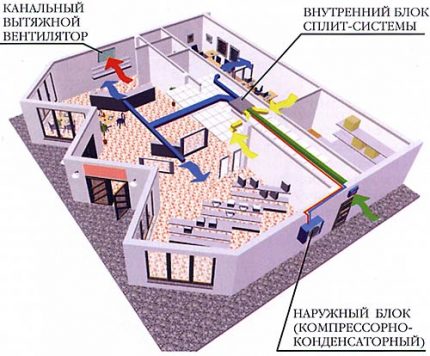
The external design of the system is equipped with such necessary elements as a condenser heat exchanger with a fan, a compressor, a protection device, a control unit, and the external part - the case. The block should be placed on the outer wall of the object with minimal access to sunlight.
Among the advantages of the unit, the following aspects are distinguished:
- minimal interference with the design of the room;
- it is possible to condition several or one room of a large area at the same time;
- cooling and heating of air flows is possible even with a constant mixture of fresh air.
In addition to the advantages, users highlight some negative aspects of using the channel type of device.
For example, of the main disadvantages are:
- maintaining a single temperature regime without the possibility of regulating it in various rooms;
- the ability to install only in rooms with high ceilings;
- for installation, you will need to use the services of specialists with the goal of correctly positioning the ducts and the entire system as a whole;
- high cost of the system.
The channel type of ceiling air conditioners is distinguished by the ability to maintain a constant temperature, and some models are equipped with a dehumidification function, can work in night mode.
The average price for such devices is 60-80 thousand rubles, and premium offer from 120 thousand rubles.
View # 3 - floor-to-ceiling devices
Devices are distinguished by the possibility of their installation under the ceiling, and if necessary - on the floor.

The internal case of the device has a flat design, so it does not visually clutter up the space. It can be installed in a vertical or horizontal position: the wider part is fixed to a wall or ceiling.
Ceiling units are intended for use in rooms for domestic and commercial use - living rooms, warehouses and utility rooms, cafes, cinema complexes, etc.
Functionally, this type performs the following actions: cooling, heating, cleaning of air flows.
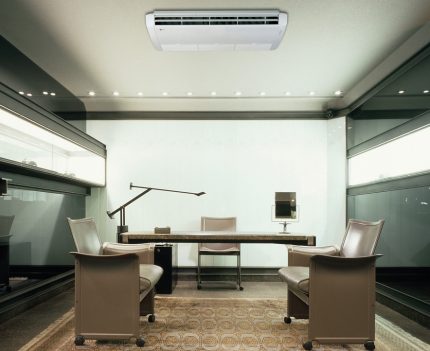
The function of heating the air masses is possible only with devices that are equipped with a heat pump.
The internal design of the device consists of the following elements:
- body - the external part of the device;
- evaporator heat exchanger - performs the function of removing heat from air flows in cooling mode;
- domestic centrifugal fans - capture air masses from the room, moving them through the heat exchanger and filter elements;
- control unit - designed to enable the necessary functions.
Air conditioning is filtered by an air filter element, which is also located in the indoor unit.
The external design of the system is installed on the wall of the building and connected to the internal using the inter-unit freon route.
The design of the device is similar to the previous types of ceiling units. Its main functional elements are heat exchanger and condenser fan, compressor, control board, protection device.
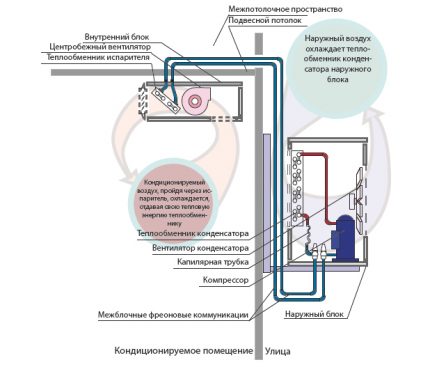
The functional element is combined with the internal circuit due to freon communications, which form a single closed system.
Of the advantages of this type of air conditioner, there is a uniform distribution of air conditioning air flows throughout the room, the possibility of installation on any type of ceiling, low noise level and low cost of installation work.
The negative side of the devices is the high cost and lack of the ability to install in the inter-ceiling space.
Rating of ceiling split systems
Hyundai H-ALC3-18H
Impeccably assembled unit for cooling and heating
The climate system of the ceiling type produces cooling and heating of premises, the area of which does not exceed 54 square meters. m. Lowers air humidity at a speed of 1.8 l / h, performs ventilation in three high-speed modes. The model is in demand mainly in the arrangement of commercial, industrial, office premises.
The temperature minimum supported by the equipment is + 17ºС. The split system is equipped with a timer for transferring the launch and a display for tracking performance. For ease of operation, an infrared remote control is included.
Specifications:
- modes - cooling, heating, drainage, ventilation;
- power (cooling / heating) - 5300 W / 5900 W;
- power consumption (cooling / heating) - 1712 watts/1793 watts;
- maximum air supply - 21.67 cc m / min;
- length of communications - up to 25 m;
- temperature minimum during heating - 15ºС;
- cleaning devices - coarse filter;
- mass of blocks (indoor / outdoor) - 20/42 kg;
- energy efficiency class - B;
- additional functionality - automatic maintenance of the set temperature, storing settings, self-diagnosis, timer, display, adjusting the air flow direction, night mode, anti-icing system;
- noise level (minimum / maximum) - 34/41 dB
The unit works perfectly in all available modes.It functions quite quietly, does not interfere with the owners to relax. Heating produces on cool and frosty days, during which the temperature does not fall below -15 ° C.
The list of minuses is headed by low energy efficiency. Not happy owners lack of a device for fine filtering, ionization and deodorization of the air mass. The purchase is not too prone to price.
- Stable work in all modes
- Simple, clear controls
- Environmentally friendly refrigerant
- Quality assembly
- Lightweight indoor unit
- Low energy efficiency
- Not high enough air purification
Timberk AC TIM 36LC CF5
Powerful and efficient cooling and heating equipment
The floor-and-ceiling version of the split system will heat and cool the air in rooms with a surface area of less than 100 square meters. m. Eliminates excess moisture, ventilates in three different speed modes. Ideal for arranging trading floors, restaurants, sports complexes.
The design is equipped with a timer that allows you to postpone the launch to the optimal time for the owners. The control uses an infrared remote control. Split heating will be performed at a temperature outside the window not lower than -15ºС.
Specifications:
- modes - cooling, heating, drainage, ventilation;
- power (cooling / heating) - 10,600 watts/11700 W;
- power consumption (cooling / heating) - 3,772 watts/3,500 watts;
- maximum air supply - 25.0 cu m / min;
- length of communications - up to 50 m;
- temperature minimum during heating - 15ºС;
- cleaning devices - coarse filter;
- mass of blocks (indoor / outdoor) - 33/71 kg;
- energy efficiency class - C;
- additional functionality - automatic maintenance of the set temperature, storing settings, self-diagnosis, timer, adjusting the air flow direction, night mode, anti-icing system;
- noise level (minimum / maximum) - 41/50 dB.
The climate system is charged with environmentally friendly refrigerant. Its use leads to a rather low energy efficiency of the installation.
A disadvantage is the lack of a multi-level cleaning system, as well as devices for ionizing and deodorizing the treated air. Not everyone is comfortable with the noise level at normal settings. But when switching to night mode, sound interference is reduced.
- High speed air treatment
- Quality assembly
- Environmentally friendly refrigerant
- Self-diagnosis for timely troubleshooting
- Impeccable work in all modes
- Low energy efficiency
- Noise at normal settings
- Not high enough air purification
Shivaki SFH-184BE / SUH-184BE
Universal floor and ceiling model
The split system developed by the Japanese copes excellently with cooling and heating rooms, the area of which does not exceed 50 square meters. m. A universal unit performs air drainage at a speed of 1.9 l / h. If necessary, the model plays the role of a fan.
The climate control is extremely simple. Comfort control provides the presence of an infrared remote control. To transfer the start of work there is a timer.
Specifications:
- modes - cooling, heating, drainage, ventilation;
- power (cooling / heating) - 5300 W / 5900 W;
- power consumption (cooling / heating) - 1900 W/1690 watts;
- maximum air supply - no data;
- temperature minimum during heating - 7ºС;
- cleaning devices - coarse filter;
- mass of blocks (indoor / outdoor) - 28/41 kg;
- energy efficiency class - A;
- additional functionality - automatic maintenance of the set temperature, storing settings, self-diagnosis, timer, adjusting the air flow direction, anti-icing system;
- noise level (minimum / maximum) - 43/53 dB.
The system is equipped with a conventional compressor, but has a relatively low power consumption. Dressed with environmentally friendly freon. The weighty benefits include an affordable price. Not all owners of the air conditioning system are satisfied with the noise during the operation of the fan.
- Impeccable build quality
- Economical energy consumption
- Self-diagnosis for timely troubleshooting
- Simple and convenient operation
- Environmentally friendly refrigerant
- Fan noise
- Carrying out heating only to -7ºС
- Not high enough air purification
Toshiba RAS-B10UFV-E / RAS-10SAV2-E
Superior model with multi-stage air purification
The indoor unit of the Thai climate system can be mounted both on the floor and on the ceiling. The unit performs cooling, heating, lowers the level of humidity and ventilates the air in domestic premises. The equipment is equipped with an inverter type of compressor, providing a smooth start and stable operation.
The model is simple and extremely easy to use. It can be used in underfloor heating. For ease of operation, an infrared remote control is included. Choose the optimal time to start the process allows the timer.
Specifications:
- modes - cooling, heating, drainage, ventilation;
- power (cooling / heating) - 2500 W / 3200 W;
- power consumption (cooling / heating) - 600 watts/750 watts;
- maximum air supply - 7.78 cubic meters. m / min;
- length of communications - up to 15 m;
- temperature minimum during heating - 15ºС;
- cleaning devices - coarse and fine filter, deodorizing filter;
- mass of blocks (indoor / outdoor) - 14/35 kg;
- energy efficiency class - A;
- additional functionality - automatic maintenance of the set temperature, storing settings, self-diagnosis, timer, adjusting the air flow direction, night mode, anti-icing system;
- noise level (minimum / maximum) - 23/39 dB.
The owners of this HVAC equipment note that there are no drafts during its operation. Therefore, it is ideal for arranging nurseries, and indeed all frequently visited premises in general. The disadvantages include only too high a price.
- High speed air treatment
- Multi-Level Cleaning System
- Self-diagnosis for timely troubleshooting
- Environmentally friendly refrigerant
- The ability to heat the floor
- Overly high price
Mitsubishi Electric MFZ-KJ25VE / MUFZ-KJ25VE
Perfectly functioning split system with wide functionality
The indoor unit of the split system is universal - it can be installed on the floor or mounted on the ceiling. This model is designed to form an optimal microclimate in rooms up to 20 square meters. m. Heats, cools, reduces humidity, ventilates in five high-speed modes.
Comfortable control of the system provides an infrared remote control. The timer allows you to transfer the start of air processing to a time convenient for owners.
Specifications:
- modes - cooling, heating, drainage, ventilation;
- power (cooling / heating) - 2500 W/3400 W;
- power consumption (cooling / heating) - 540 W / 770 W;
- maximum air supply - 8.20 cubic meters. m / min;
- length of communications - up to 20 m;
- temperature minimum during heating - 15ºС;
- cleaning devices - coarse filter, deodorizing filter;
- mass of blocks (indoor / outdoor) - 15/37 kg;
- energy efficiency class - A;
- additional functionality - automatic maintenance of the set temperature, storing settings, self-diagnosis, timer, adjusting the air flow direction, night mode, anti-icing system;
- noise level (minimum / maximum) - 20/39 dB.
The presence of a deodorizing filter ensures the rapid removal and neutralization of unpleasant odors. However, the split filter is not equipped with a fine filter collecting dust suspended in the air - this is a minus for equipment of this price category.
- High speed air treatment
- Environmentally friendly refrigerant
- Self-diagnosis for timely troubleshooting
- Low noise
- Economical energy consumption
- Overly high price
LG UV36 / UU37
Flawless powerful climate control unit
This model is designed for cooling and heating rooms up to 108 square meters. m. The indoor unit can be installed on the floor or fixed to the ceiling under a suspended or plasterboard ceiling system. If necessary, the unit lowers the humidity level and ventilates in three high-speed modes.
Management is carried out using an infrared remote control. The timer allows delaying the launch of the split system for the required period.
Specifications:
- modes - cooling, heating, drainage, ventilation;
- power (cooling / heating) - 10000 W / 11000 W;
- power consumption (cooling / heating) - 3720 W / 3780 W ;
- maximum air supply - 29.0 cu m / min;
- communication length - no data;
- temperature minimum during heating - 20ºС;
- cleaning devices - coarse filter, antibacterial filter;
- mass of blocks (indoor / outdoor) - 35/85 kg;
- energy efficiency class - A;
- additional functionality - automatic support of the set temperature, storing settings, timer, night mode, anti-icing system;
- noise level (minimum / maximum) - 40/44 dB.
A reasonable advantage of the model is the presence of an antibacterial filter. It will work in heating mode up to -20ºС on the street - also a weighty advantage. But the cost of equipment is not all conducive to the purchase and installation.
- High speed air treatment
- Economical energy consumption
- The presence of an antibacterial filter
- Environmentally friendly refrigerant
- Flawless operation in all modes
- Unreasonably high price
IGC IFM-18H / U
Efficient, affordable system
The split system quickly cools and heats residential, office and commercial premises with an area of up to 50 square meters. m. Dries the air and ventilates if necessary. It is popular among owners of apartments and private houses, small commercial establishments, production shops, and workshops.
The indoor unit can be placed on the floor or fixed on the ceiling, covered with a stretch or plasterboard ceiling system. For convenience, an infrared remote control is attached to the model.
Specifications:
- modes - cooling, heating, drainage, ventilation;
- power (cooling / heating) - 5100 W / 5500 W;
- cooling power consumption -2950 watts;
- maximum air supply - 21.67 cubic meters. m / min;
- length of communications - up to 25 m;
- temperature minimum during heating - 15ºС;
- cleaning devices - coarse filter;
- mass of blocks (indoor / outdoor) - 24 / 36.5 kg;
- energy efficiency class - no data;
- additional functionality - automatic maintenance of the set temperature, storing settings, self-diagnosis, timer, adjusting the air flow direction, night mode, anti-icing system;
- noise level (minimum / maximum) - 43/58 dB.
The minimum limit of the maintained temperature in the cooling mode is -17ºС. The indisputable advantages of consumers include an affordable price. The minus is that they consider an insufficient degree of filtration, i.e. lack of a fine filter.
- Quality assembly
- Self-diagnosis for troubleshooting
- Affordable price
- Inadequate air purification
GENERAL AGHG09LVCB
Split System Improving Air Composition
GENERAL AGHG09LVCB will quickly and efficiently cool or warm the air in a room with an area of up to 25 square meters. m. The equipment lowers the humidity level at a speed of 1.3 l / h, produces ventilation. Owners of apartments and private houses buy a model.
The timer allows you to postpone the start of air processing at a convenient time for the owners. Ease of control is enhanced by the presence of an infrared remote control; the mode selection scheme is extremely simple and straightforward. Integration into the Smart Home system is provided.
Specifications:
- modes - cooling, heating, drainage, ventilation;
- power (cooling / heating) - 2600 W / 3500 W;
- power consumption (cooling / heating) - 530 watts/790 watts;
- maximum air supply is 9.50 cubic meters. m / min;
- length of communications - up to 20 m;
- temperature minimum during heating - 25ºС;
- cleaning devices - coarse and fine filters, deodorizing filter;
- weight of the outdoor unit - 54 kg;
- energy efficiency class - A ++;
- additional functionality - anion generator, automatic maintenance of the set temperature, storing settings, self-diagnosis, timer, adjusting the air flow direction, night mode, anti-icing system;
- noise level (minimum / maximum) - 22/40 dB.
The list of reasonable benefits is led by the use of an inverter compressor. The owners of this technique really like the multi-level cleaning system, complemented by a deodorizing filter and anion generator.
Heats up the system until the temperature outside the window drops by more than -25ºС. Among the shortcomings is only a high price.
- Multistage air purification system
- Wide temperature range
- Environmentally friendly refrigerant
- High price
Electrolux EACU-18H / UP2 / N3
Equipment with "average" characteristics and price
Split system Electrolux EACU-18H / UP2 / N3 copes with air processing in rooms up to 50 square meters. m. Its internal module can be located at floor level or on the ceiling. Multifunctional equipment reduces humidity and ventilates. It is acquired mainly by owners of small commercial enterprises, less often by owners of private houses.
In operation, the split system is simple and convenient, for remote control there is a remote control. It can be integrated into the Smart Home equipment complex, tied to fire alarm sensors or to devices that respond to an open door. There is a timer for transferring the start of air treatment.
Specifications:
- modes - cooling, heating, drainage, ventilation;
- power (cooling / heating) - 5000 W / 5500 W;
- power consumption (cooling and heating) - 1600 watts;
- the maximum volume of air supply is 13.33 cubic meters. m / min;
- length of communications - up to 20 m;
- temperature minimum during heating - 10ºС;
- cleaning devices - coarse filter;
- mass of blocks (indoor / outdoor) - 27/37 kg;
- energy efficiency class - A;
- additional functionality - automatic maintenance of the set temperature, storing settings, self-diagnosis, timer, air flow direction adjustment, night mode, anti-icing system, warm start;
- noise level (minimum / maximum) - 34/43 dB.
The unit will only work on heating up to -15ºС, which is not bad, but there are splits with a wider temperature range. The unit has a fairly high class for economical energy consumption, but it is also not the most economical model.
The system does not perform fine cleaning, does not ionize and deodorizes the processed air mass, which can be considered a minus. The rest of the model is a simple and not too expensive "average".
- High speed air treatment
- Acceptable price
- Self-diagnosis for troubleshooting
- Possibility of integration into the Smart Home system
- Environmentally friendly refrigerant
- Low air purification
Royal Clima CO-F36HN
Powerful split system for offices and manufacturing
Climatic system Royal Clima CO-F36HN perfectly cools and heats rooms up to 100 square meters. m. If necessary, lower the level of humidity in the air and perform ventilation. The model is popular with owners of commercial establishments, small enterprises, gyms. Less often acquired by the owners of country houses and city apartments.
Even inexperienced users will not have problems managing the system. For the convenience of choosing a mode and sending commands, an infrared remote control is attached to the unit. To delay the start at the right time allows the timer.
Specifications:
- modes - cooling, heating, drainage, ventilation;
- power (cooling / heating) - 10,600 watts/11700 W;
- power consumption (cooling / heating) -3,770 watts/3,500 watts;
- the maximum volume of air supply is 25.0 cubic meters. m / min;
- length of communications - up to 30 m;
- temperature minimum during heating - 15ºС;
- cleaning devices - coarse filter;
- mass of blocks (indoor / outdoor) - 34/89 kg;
- energy efficiency class - no data;
- additional functionality - automatic maintenance of the set temperature, storing settings, self-diagnosis, timer, adjusting the air flow direction, night mode, anti-icing system;
- noise level (minimum / maximum) - 41/50 dB.
The system is powered by a three-phase network, which by default limits the scope of its application. It does not produce fine purification and ozonation of air. However, for such powerful equipment, it has an affordable price.
- High speed air treatment
- Self-diagnosis for troubleshooting
- Environmentally friendly refrigerant
- Low degree of air filtration
- Noisy ventilation
Device Recommendations
When buying HVAC equipment, one should pay attention to the configuration, appearance, and also take into account technical indicators that affect system performance. Consider in more detail the main criteria for the proper selection of equipment.
Brand and grade level
Like all devices, split-systems are produced in budget, medium and premium versions, which differ in cost and their functionality. It is better to purchase a unit of a popular manufacturer with a good reputation.

The most popular brands of cassette devices are Shivaki, Electrolux and Hisense. However, the cost of these devices varies between 70-100 thousand rubles. Among channel equipment brands are in demand Mitsubishi electric, Haier, General climate. The price range on them is from 40 to 120 thousand rubles. The best brands of floor-to-ceiling units, the users named the following: Panasonic, Shivaki, Daikin and LG. These brands produce middle and premium class equipment.
Determination of equipment power
Another important criterion is power in the air mass cooling mode. This indicator is expressed in British thermal units, the English abbreviation is BTU. 1 BTU equals 0.3 watts.
The technical characteristics of the device can indicate the cooling power in BTU or in electric watts, which allows you to determine for what area the device is suitable.
Since the cooled air flows move down and concentrate near the floor, when selecting the unit, it is not the volume of space that is taken into account, but its area.
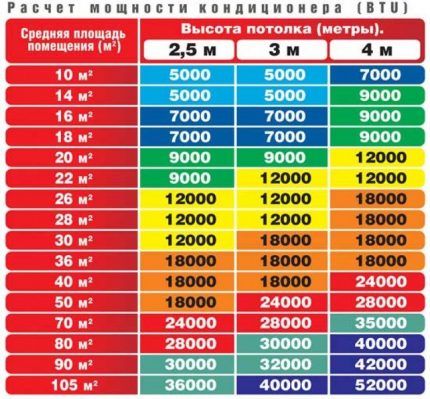
Based on tabular data, for small rooms up to 25 m2 split systems with a capacity of 7 or 9 BTU are suitable, and for spacious rooms 50-60 m2 it is better to buy with an indicator of 18, 24 BTU. In more detail, we considered the issue of calculating the system power in this article.
Noise level of climatic equipment
This indicator is very important for those who plan to install an air conditioning system in the bedroom or library. In such rooms, the user often relaxes, and excess noise will distract him.
Therefore, for the equipment of an apartment, house or other residential building, it is recommended to use devices with low noise - 26-36 dB for an indoor unit and up to 54 dB for an outdoor structure.

Rules for installing split systems
Comfort in the room where the installation of the air conditioning system is planned depends not only on the technical parameters of the device, but also on the correctness of its installation.
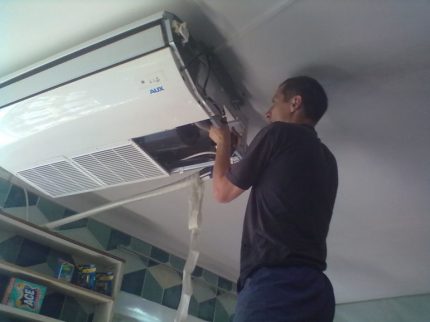
Therefore, it is better to initially perform all the steps correctly in order to save on the repair or purchase of new climate equipment.
Let's take a step-by-step look at how to install the ceiling system correctly.
Stage # 1 - installation of equipment blocks
Depending on the type of ceiling air conditioner, you should decide on the future location of the internal structure. Cassette and duct units are installed in a free area between the main and suspended ceilings.
The inner part of the cassette unit is installed in special suspensions, which are fastened with anchor bolts in one or more cells of the suspended ceiling.
The channel type of equipment can have several air ducts in each room, which are connected to the indoor unit and connected to the distribution grilles. Installation is carried out over a suspended structure, so it is better to perform it before installing the ceiling.
The number and length of ducts is determined based on the parameters and area of the room. We recommend that you familiarize yourself with calculation rules ductwork.
After installing the structure, the air ducts are insulated, soundproofed to prevent condensation and increased noise during operation.
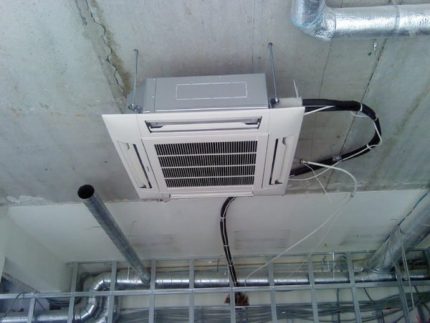
Floor-and-ceiling units are attached to the ceiling using fixing bolts with M10 thread with strict horizontal compliance. If necessary, the ceiling structure is strengthened and leveled.
Installation steps:
- Drilling holes in the wall with access to the street with a diameter of 55 mm.
- Routing the cable duct from the hole to the indoor unit.
- Choosing the optimal location and marking future holes for the brackets for securely fixing the outdoor unit.
- Drilling holes, fixing brackets, mounting an external unit.
- Installation of the internal structure depending on the type of split system.
- Connection of the drainage system to the internal structure.
- Connecting electricians to the system.
- Laying the route: thermal insulation is put on the copper pipeline, the tubes are flared and connected to two blocks.
The tightness of the structure depends on the reliability of the connection of the tubes with the external and external units, which directly affects the operability of the device.
Stage # 2 - crimping and evacuation of the system
After laying inter-unit communications, the trunk is checked for integrity and tightness.
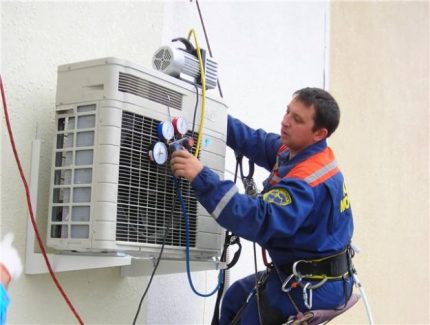
When it is established that the system is tight, the line is filled with refrigerant.
Most aggregate models use two-component R 410A freon without chlorine, which is safe for the ozone layer.
If the track is long enough, then additional refueling of the air conditioning system with refrigerant will be required. Features of a self-fueling system we reviewed here.
Stage # 3 - commissioning
After assembling the system, performing a vacuum and filling it with freon, you will need to check the operability of the device and make sure there are no leaks. To do this, turn on the device and start it in all operating modes.
When the device’s operability is checked, it is necessary to perform the final steps: seal the strob with mounting foam, silicone sealant, cement mortar, as well as remove debris, dust and residual materials in the room.

Conclusions and useful video on the topic
An example of installing a cassette unit in a magazine:
Recommendations for the placement of channel devices in the room:
Installation of floor and ceiling systems in a restaurant:
The considered types of ceiling split systems differ in similar installation, the principle of operation, however, they have various positive and negative aspects.
When choosing a unit, a set of parameters, technical characteristics and functional features should be taken into account in order to maximize the organization of air conditioning in the room.
Do you want to supplement the above material with useful comments? Or do you still have questions about the principle of operation or the features of choosing a ceiling split system? Leave your comments, ask questions of interest in the block below.

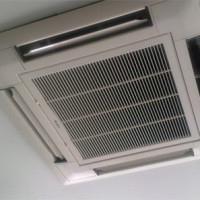 Cassette split system: design features, pros and cons of technology + installation nuances
Cassette split system: design features, pros and cons of technology + installation nuances  Midea split systems: TOP-10 of the best models + recommendations for choosing a technique
Midea split systems: TOP-10 of the best models + recommendations for choosing a technique 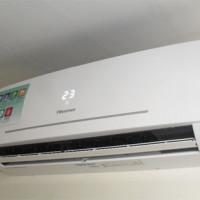 Hisense split systems rating: top 10 models + recommendations for choosing brand equipment
Hisense split systems rating: top 10 models + recommendations for choosing brand equipment  Inverter split systems: ranking of the best models in today's market
Inverter split systems: ranking of the best models in today's market 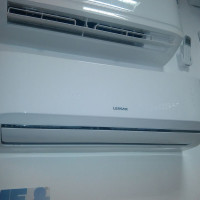 TOP-10 Split systems Lessar: features of models + nuances of the choice of climatic equipment
TOP-10 Split systems Lessar: features of models + nuances of the choice of climatic equipment  Samsung split systems: ranking of the best models + recommendations before buying
Samsung split systems: ranking of the best models + recommendations before buying  How much does it cost to connect gas to a private house: the price of organizing gas supply
How much does it cost to connect gas to a private house: the price of organizing gas supply  The best washing machines with dryer: model rating and customer tips
The best washing machines with dryer: model rating and customer tips  What is the color temperature of light and the nuances of choosing the temperature of the lamps to suit your needs
What is the color temperature of light and the nuances of choosing the temperature of the lamps to suit your needs  Replacement of a geyser in an apartment: replacement paperwork + basic norms and requirements
Replacement of a geyser in an apartment: replacement paperwork + basic norms and requirements
For our home, we chose the floor-and-ceiling view of the split system. Earlier we met such people at the hotel and we liked this option. With such a split system, the interior seems simple. The split system is almost invisible, and works just as well as wall-mounted air conditioners. The model is also well suited to low ceilings, because there is not much space, and if a huge air conditioner hangs on the wall, the design of the room will be spoiled.